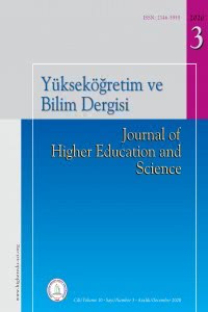Yükseköğretimin Çevresel Koşullarının Değerlendirilmesi: Porter’ın Beş Güç Modelini Kullanarak Teorik Bir Yaklaşım
Yükseköğretime artan talep ve beraberinde getirdiği değişim ve rekabet süreci birçok çalışmaya konu olmuştur. Rekabet denildiğinde akla gelen en önemli isimlerden birisi de Porter’dır. Onun beş güç modelinde, “sektöre yeni girenlerin karşılaşacağı engeller, ikame ürünlerin tehdidi, alıcıların pazarlık gücü, tedarikçilerin pazarlık gücü ve firmalar arasındaki rekabet unsuru” olarak adlandırılan beş faktör, bir endüstri alanının dış çevre koşullarından kaynaklanan fırsatları ve tehditleri anlamak için kullanılır. Beş güç modeli, bir endüstri alanındaki kârlılık düzeyini ve rekabet yoğunluğunu belirlemek için analitik bir araç olarak sıklıkla kullanılmıştır. Böylelikle yöneticiler rekabet güçlerine karşı kurumları için strateji geliştirme ve kendilerini savunma yollarını keşfetme imkânına sahip olmuşlardır. Literatürde, bu model ile ilgili farklı sektörlerde çok sayıda çalışma karşımıza çıkmasına rağmen, yükseköğretim alanının kârlılık ve rekabet faktörleriyle birlikte bir sektör olarak değerlendirilip değerlendirilmeyeceğine dair yaşanan kararsızlık yüzünden, teorinin bu alan ile ilgili uygulamalarına çok da fazla rastlanamamaktadır. Özellikle bizim ülkemizde, yükseköğretimin bir sektör olarak görülmesi fikrinin batıya kıyasla daha tartışmaya açık bir husus olması, konuyla ilgili bir çalışmaya rastlayamamamızı açıklar bir sebep olarak görülebilir. Bu makalede, ilgili literatür çerçevesinde, beş güç modeli yükseköğretim alanı ile bağlantılı bir şekilde ele alınacak, sonrasında bu çerçevede ortaya konulan faktörler ve değerlendirmeler Türk yükseköğretiminin dış çevre koşulları ile ilişkilendirilmeye çalışılacaktır. Elde konuyla ilgili derli toplu kaynaklar ve yeterli veriler olmadığından, Türk yükseköğretim alanı ile olan ilişkilendirme çok detaylı yapılmayacak, yükseköğretim alanına yönelik dış çevre koşullarından gelebilecek tehdit ve fırsatları görebilmek için genel bir yaklaşım elde edilmeye çalışılacaktır. Çalışma ile ortaya konulan bu teorik alt yapının politikacılara, üniversite yöneticilerine ve akademisyenlere farklı bir bakış açısı kazandırmasının yanı sıra ileride Türk yükseköğretim alanının sunduğu fırsat ve tehditleri analiz etmek ve uygun stratejiler geliştirmek için yapılacak olan araştırmalara vizyon sağlaması ve temel oluşturması da umut edilmektedir
Assessing the Environmental Conditions of Higher Education: In a Theoretical Approach Using Porter’s
Increased demand for higher education and the change and competition it has brought have been a subject for many studies. In Porter’s five forces model, forces termed as the threat of new entrants, threat of substitute products, bargaining power of suppliers, bargaining power of customers, and established rivals between the companies are used to understand the threats and opportunities posed by the industry’s environmental circumstances. The five forces model has been extensively used as an analytical tool to determine the intensity of rivalry and levels of profitability. Thus, managers can develop strategies and discover ways to defend their companies against competitive forces. Although there have been numerous studies conducted with this model for various sectors, the studies implementing this theory to higher education are very scarce due to uncertainty about whether higher education could be regarded as an industry together with its profitability and rivalry components. Specifically, in Turkey, with the idea of considering higher education to be an industry being disputable compared with western countries and even regarded as unmannerly and disloyal to academia explains the lack of studies on this subject. In this study, within the scope of the related literature, the five forces model will be discussed in conjunction with higher education. Subsequently, the factors and evaluations that are shown within this scope will be associated with the external environmental conditions of Turkish higher education. Since there is a lack of well-written sources and sufficient data, the association with Turkish higher education will not be deeply detailed. To perceive the threats and opportunities to higher education from external environmental conditions, an overall approach will be achieved. The theoretical substructure introduced by this study will bring a different viewpoint to politicians, university directors and academicians, along with being a basis for and providing vision to studies analyzing the threats and opportunities presented to Turkish higher education to develop proper strategies
___
- Altbach P. G., Reisberg L., & Rumbley L. E., (2009). Trends in global higher education: Tracking an academic revolution—A report prepared for the UNESCO 2009 world conference on higher education. Paris: UNESCO.
- Altunay, T. E. (2010). Profile of students and the reasons why they prefer private universities in Turkey. Doctoral dissertation. Boğaziçi University, Institute of Social Sciences, 2010, İstanbul, Turkey
- Anand, K. A. (2012). Business of higher education–a business model for a higher education institution. International Journal of Business and Management Tomorrow, 2(2), 1-7.
- Albanese, M. (1999). Students are not customers: a better model for medical education. Academic Medicine, 74(11), 1172-86.
- Asaad, Y. (2011). An investigation into export market orientation in UK universities from the international marketing managers’ perspective: A mixed-method approach. PhD submitted to University of Brunel. Retrieved from http://bura.brunel.ac.uk/ bitstream/2438/5838/1/FulltextThesis.pdf.
- Aydin, O. T., & Bayir, F. (2016). The impact of different demographic variables on determinants of university choice decision: a study on business administration students of the foundation universities in Istanbul. Educational Sciences: Theory and Practice, 16(4), 1147-1169.
- Baron, P., & Corbin, L. (2012). Student engagement: rhetoric and reality. Higher Education Research & Development, 31(6), 759- 772.
- Bay, D., & Daniel, H. (2001). The student is not the customer: An alternative perspective. Journal of Marketing for Higher Education, 11(1), 1-19.
- Belanger, C., Mount, J., & Wilson, M. (2002). Institutional image and retention. Tertiary Education and Management, 8(3), 217–230.
